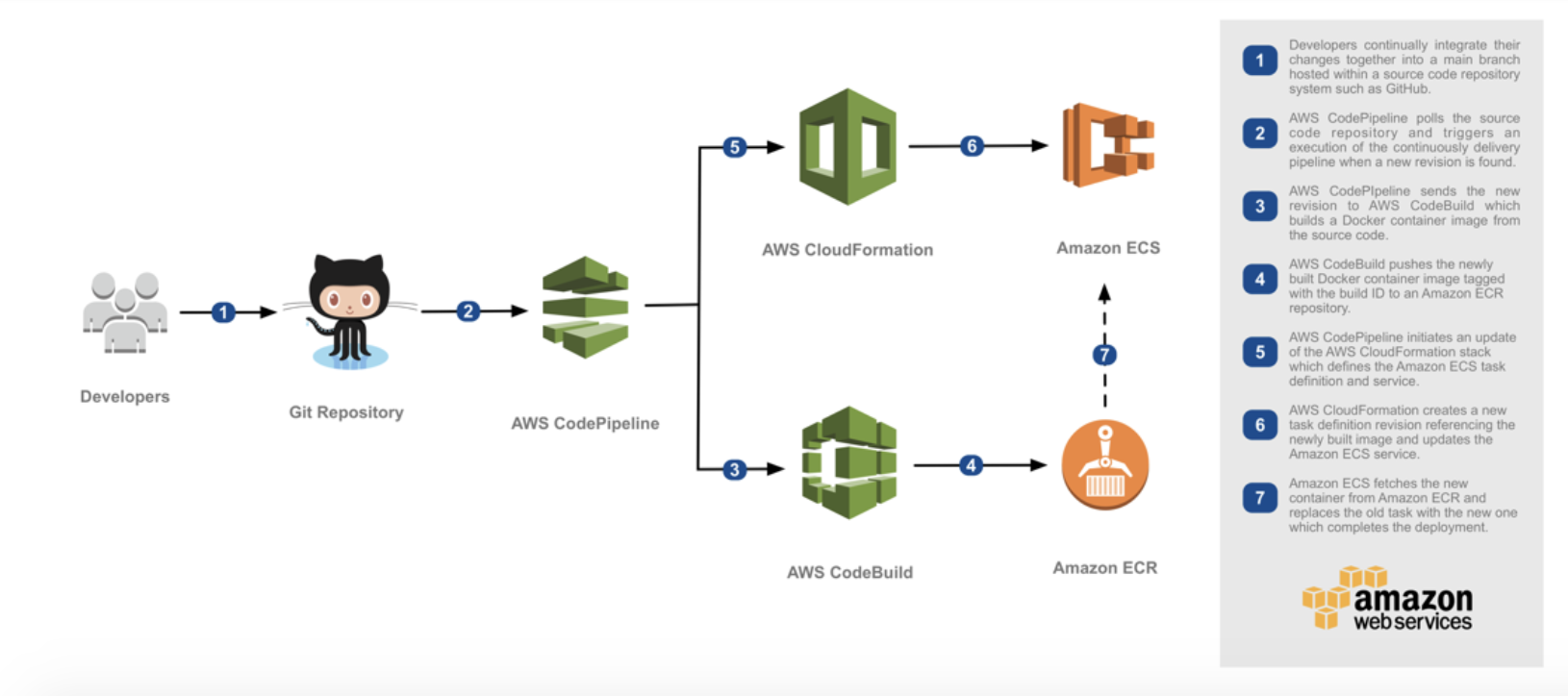Create a Hello World Web Service on AWS
Question
You are a new graduate and are trying to get an AWS DevOps job.
To prepare for a tech interview, the recruiter has given you a task to use AWS to build up a Hello World web service in one week.
Answers
Explanations
Click on the arrows to vote for the correct answer
A. B. C. D.Correct Answer C.
The below is a pipeline that has used the required services for a web service:
irst, in the Source stage, the pipeline is configured with details for accessing a source code repository system.
CodeCommit can be used at this stage.
Secondly, the Build stage uses CodeBuild to create a new Docker container image based upon the latest source code and pushes it to an ECR repository.
CodePipeline also integrates with a number of third-party build systems, such as Jenkins, CloudBees, Solano CI, and TeamCity.
Finally, the Deploy stage uses CloudFormation to create a new task definition revision that points to the newly built Docker container image and updates the ECS service to use the new task definition revision.
After this is done, ECS initiates a deployment by fetching the new Docker container from ECR and restarting the service.
The details can be found in https://aws.amazon.com/blogs/compute/continuous-deployment-to-amazon-ecs-using-aws-codepipeline-aws-codebuild-amazon-ecr-and-aws-cloudformation/.
Option? ?A is ?incorrect because firstly it should be a Build stage rather than a Staging stage.
Secondly, it should generate a Docker image and push it to ECR for ECS to use later on.
Option? ?B is ?incorrect because the new Docker image should be put in ECR for ECS to use.
S3 is not the correct place for Docker images.
Moreover, in Deploy stage, CloudFormation should create an ECS task definition rather than an ECS cluster for each deployment activity.
Option? D? ?is? ?incorrect because in Build stage, CodeBuild should generate a Docker image and push it to ECR.
A RPM package or an executable file cannot be put into ECR.

Sure, I'd be happy to help!
The task given by the recruiter is to build a "Hello World" web service using AWS. To accomplish this task, the candidate needs to use AWS services such as CodePipeline, CodeBuild, CloudFormation, and ECS (Elastic Container Service).
Now, let's go through each of the given options and analyze their approaches.
Option A:
This option involves using CodePipeline to automate the software release process, CodeBuild to build the new artifact, S3 to store the artifact, and CloudFormation to create a new task definition revision that points to the installation package in S3 and updates the ECS service to use the new task definition revision.
The pipeline starts with a source stage that uses CodeCommit to fetch the source code. Then, a staging stage is added, which uses CodeBuild to build the new artifact (an RPM package or an executable file) and store it in S3. Finally, a deploy stage is added that uses CloudFormation to create a new task definition revision that points to the installation package in S3 and updates the ECS service to use the new task definition revision.
Option B:
This option also involves using CodePipeline, CodeBuild, S3, CloudFormation, and ECS. However, instead of building an RPM package or an executable file, it builds a new Docker container image and stores it in S3. The pipeline starts with a source stage that uses CodeCommit to fetch the source code. Then, a build stage is added that uses CodeBuild to build a new Docker container image and store it in S3. Finally, a deploy stage is added that uses CloudFormation to create a new ECS Cluster that points to the S3 URL with the newly built Docker container image and updates the relevant ECS service.
Option C:
This option also uses CodePipeline, CodeBuild, S3, CloudFormation, and ECS, but it builds a Docker container image and pushes it to ECR (Elastic Container Registry) instead of S3. The pipeline starts with a source stage that uses CodeCommit to fetch the source code. Then, a build stage is added that uses CodeBuild to build a new Docker container image and push it to ECR. Finally, a deploy stage is added that uses CloudFormation to create a new task definition revision that points to the newly built Docker container image and updates the ECS service to use the new task definition revision.
Option D:
This option is similar to option C, but it builds the new artifact (an RPM package or an executable file) and pushes it to ECR instead of building a Docker container image. The pipeline starts with a source stage that uses CodeCommit to fetch the source code. Then, a build stage is added that uses CodeBuild to build the new artifact and push it to ECR. Finally, a deploy stage is added that uses CloudFormation to create a new task definition revision that points to the newly built Docker container image and updates the ECS service to use the new task definition revision.
In conclusion, the most suitable answer to this question would be option C. Building a Docker container image and pushing it to ECR is a better approach than building an RPM package or an executable file, and storing it in S3. Additionally, ECR is a more suitable service for storing container images. Finally, updating the ECS service to use the new task definition revision is a standard practice in DevOps and is done through CloudFormation in this case.